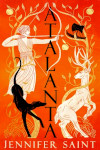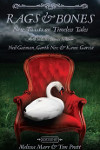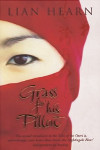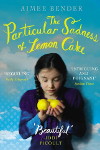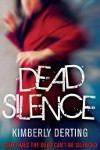Lian Hearn – Across The Nightingale Floor
Posted 11th June 2012
Category: Reviews Genres: 2000s, Angst, Domestic, Fantasy, Historical, LGBT, Paranormal, Romance, Social
2 Comments
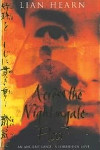
A rather epic historical flavoured with fantasy.
Publisher: Picador
Pages: 292
Type: Fiction
Age: Young Adult
ISBN: 0-330-49334-5
First Published: 2002
Date Reviewed: 9th February 2011
Rating: 4/5
Please note that I wrote most of this review over a year ago and that the tone is different due both to the shift in my writing style and the fact that I wanted to make reference to the book being a re-read. I suppose you could call it the ultimate reflective review.
On the day his village was burned to the ground, Tomasu was found by a Lord who named him Takeo and took him under his wing. Now Takeo joins Lord Otori in wanting revenge, and it appears Lord Otori chose well, for when Takeo stops speaking through shock, magical talents begin to show themselves. Takeo’s not sure what’s happening but he knows that with these talents he may be able to defeat the tyrant.
I first read this book around its publication date and absolutely loved it, I remember staying up all night to finish it; through this I came to discover how fantastic February mornings are as the sun rises, something I try to be awake to experience at least once a year to this day. Because of my reading speed at the time, the climax took me 45 minutes to get through and along with the historic subject I was in heaven. But reading it again I can see the flaws I didn’t see then.
The book is a brilliant example of Young Adult Asian historical fiction (albeit written by a white westerner), and it takes the reader to various different locations without any big changes in plot. The main characters are strong, the heroine especially, and the reader is able to get to know them well in a reasonably short period of time. The talents are supernatural, but they aren’t over the top, they are in the main the sorts of talents that we often think might be possible to develop, such as acute hearing.
But something that I didn’t notice the first time I read the book, due to my age, was the main character’s sexual promiscuity. The character actually appears to be a closet bisexual, but this isn’t the point, rather the point is that the romantic storyline revolves around an intensely passionate love and then a moment later the hero will go and sleep with someone else. For this reason I had a lot of trouble accepting the romance in the book whereas the first time I read it I thought it was amazingly romantic. All I felt was that he was disrespecting Kaede and their supposed love.
However apart from this the characters are exceptional. They are very much a product of their writing time, written before Young Adult books became what they are today, and are all the better for it. The plot switches between them, Takeo’s chapters being written in the first person, and Kaede’s in the third.
The book is not for the faint hearted. Hearn never shies away from descriptions of torture and death, and scenes of a sexual nature are relayed in their historical truthfulness. For fantasy this may be, but the Japanese historical aspects are rather factual.
The story has it all, the keen warrior, mystery and magic, adventure, political issues concerning leadership, and a sweeping romance. It shows why political alliances were important, but family more so, and how devastating the wrong choice could be. It displays the extreme prejudice towards women, the strong Kaede struggling to be accepted as her father’s heir and having to pass up being known as the heroine of a part of the plot that cannot be told here if the plot isn’t to be spoiled.
This is not your contemporary Young Adult novel, and should be recommended to young people with care. However that said, for its realism it is nothing more than true to historical life.
Across The Nightingale Floor is fiction for anyone who has seen a wuxia film and fallen in love, for the historian who wants to know more, and for the dreamer who believes. It is not flawless, even if the hero’s movements are, but it is a book that will hopefully stand the test of time.
Related Books
Cat Clarke – Torn
Posted 21st May 2012
Category: Reviews Genres: 2010s, Angst, Paranormal, Psychological, Romance, Social
2 Comments

No matter what, do what is right.
Publisher: Quercus
Pages: 372
Type: Fiction
Age: Young Adult
ISBN: 978-0-85738-205-4
First Published: 22nd December 2011
Date Reviewed: 18th May 2012
Rating: 4/5
Something happened on the school trip to rainy Scotland. Tara died. And although it was an accident, it could have been prevented. Alice knows all about it, she would do. But it’s difficult to tell people because of the repercussions – on her, on her friends. Yet not telling also leads to difficulties. When Tara appears as a ghost to Alice, asking her to do something about it, or rather, knowing Tara, jesting her about it all, Alice knows she has to do something. But can she, especially when there’s love in the air for her, a love that is now somewhat impossible?
Here. Now. Jack. Me. And a room full of dead lizards.
The first thing that strikes you about Clarke – it did in Entangled and does again in Torn – is just how blunt and straight to the point her writing is. Clarke doesn’t hold back, confining views and words to subtext, no, she lets it all out, hitting you smack in the face so that you are under no illusions. And it means that you become more invested in what’s going on than you might have otherwise, because if you are going to read the book, then you are damn well going know everything and accept it.
You would think that this would make for an offensive style, but Clarke is one of the best authors of young adult literature in getting to the real issues and not glossing over them. She doesn’t use lovely language in order to make her stories bittersweet, but she succeeds every single time in presenting the reader with exactly why they should do this or that or believe in something.
Because Clarke’s talent is most certainly in her storytelling, and it’s clear that she has something to say. And while she is blunt, there is no pressure, which mixed together makes a strong impact. You follow Alice’s story, her days when she wonders what she should do, and while the emphasis is on doing the right thing, Clarke does show you why it would be tempting to keep quiet, to think of how speaking out would affect your self, your life. The book is a very easy read with no slow moments, it looks like it will take no effort, but the power lies between the words, it’s woven around them and before you know it you’re knee deep in a multi-threaded story.
While the overall concept is basic, it allows the author to really analyse everything and to go into the small details. What is most interesting is that there are no sub-plots. Although at first it appears that some plot points are secondary stories, every part relates back to the main plot. You get the present, you get the future, you get the back story and the back back story, and you get it from various points of view while never straying from Alice’s first-person present tense monologue.
Alice proves an interesting choice of character because her strength takes a long time to develop, and for the most part she is very passive. Yet she represents the average teenager who wants to fit in while making sure others aren’t left out, and wanting a good life while acknowledging that doing so would cause issues. Ultimately it’s a case of everything happening at the wrong time, and the worst things that could happen colliding with the best things that could happen. And when things don’t happen as they should, there are repercussions.
The bluntness of Clarke’s writing, together with the passiveness and very much usual (in YA) personality of Alice means that the book can appeal to and catch the eye of the regular paranormal and dystopian teenage audiences, whilst giving them a few life lessons. Indeed while Lauren Oliver’s Before I Fall is a great example of how to present issues to readers, there is a lot of emphasis on the romance that somehow blurs your thoughts to the other issues at times. Clarke, on the other hand, uses romance purely to aid what she wants to say, and to demonstrate just how bad things can get. Romance is a big draw in teenage stories, and she adheres to it, but she’ll use it to get the result she wants. Not surprisingly the romance in Torn is very believable and true to life. You can believe in it because you can relate to it in some way.
And when it comes to the romance, Clarke uses her influence as a writer to educate on safe sex, in fact she makes it so that it’s the boy who points out that there is no contraception and thus it would be an idea to wait. And again, it’s real, and Clarke doesn’t portray Alice in a bad light for having said that contraception didn’t matter. The author shows that forgetting things in a moment of lust is natural and okay, but be sure you realise what the consequences would be before you continue so that you don’t continue – in other words, lust is there and that’s fine, but don’t let it control you. And always put one on. It’s a short scene with a strong message, but because she has used the message as content for dialogue it does not sound like preaching, it sounds natural, the sort of conversation a person should have, and will thus surely make readers think.
Clarke isn’t one for finishing her books with a full ending, and her work is surely better for it because it leaves you wondering about all the possibilities and dissecting which one is most likely from what you have read. She does give you all the information you need to work it out, however.
Entangled was a very promising start. Torn has cemented Clarke’s importance and talent in the young adult market.
Related Books
Erin Morgenstern – The Night Circus
Posted 19th April 2012
Category: Reviews Genres: 2010s, Fantasy, Magical Realism, Paranormal, Romance
2 Comments

The circus is all fun and games, right?
Publisher: Harvill Seeker (Random House)
Pages: 385
Type: Fiction
Age: Adult
ISBN: 978-1-846-55523-7
First Published: 13th September 2011
Date Reviewed: 17th April 2012
Rating: 5/5
Almost every night a circus appears in an undisclosed location, staying there for a short while before moving on. To the patrons it’s spectacular but still a circus with tricks. Yet for those who work for it, especially a select few, it’s more than your average magic box, being a stage for some truly amazing spells and illusions, and one particular thread of illusions in particular.
The Night Circus is a fantastic fantasy-orientated novel that lures you in unknowingly. What is most important to discern, in many ways, is that while the promise of supernatural events seems evident from the first page, from, indeed, the cover of the book, it does take a while to really show its colours. For a good length of time, although there is magic there, true magic, it does not infiltrate the circus as much as you might have thought. In many ways the circus appears to be too realistic to warrant the supposed magic and sometimes the story does not appear to be heading anywhere. But when you reach the end of the book, you can’t help but wonder if that was part of the magic in itself. The supernatural element of the book becomes very important and becomes the book’s sole reason for being towards the end.
The story is told from the third-person points of view of a number of characters. The tense usage is present which adds to the mystery. On some occasions Morgenstern brings the reader into the story, addressing them directly, and describing the circus in the second person. It’s rather like listening to a meditation instructor, the words and the overall picture being one that you don’t want to walk away from, even if at times it seems incredibly regular. While the passages about the reader obviously symbolise the present day, the chapters from the characters’ points of view are written about various difference times, jumping back and forth between the late 19th century and early 20th.
And at first all that jumping seems silly and needlessly confusing, but like the circus managers who want the audience to be able to see the performances from every angle, so Morgenstern wants to tell her story through everyone, wanting to provide the back story and future story as well as numerous “present” stories. Of course this means that for a long time it gives the impression that Morgenstern is just describing her concept, that there isn’t actually a real plot and that the book is character led – but that is where the long ending comes into play, suddenly bringing all the different threads together, explaining everything you hadn’t thought to query, and sweeping you up into a magical realism written to perfection.
Whilst one can point to two main characters in this book, there are very few characters that would be considered secondary. Each person plays a specific role, roles that often only become apparent much later. And whilst you may feel you do not know the characters well, for Morgenstern spends little time detailing their general personalities, you find that actually, you know more than you thought. And you find that the characters probably know more about you than you know about them.
The magic and paranormal elements are of two kinds; the first of the kind that people often dream is real (illusions, controlling things with the mind), and the second, which is more to do with telling the future and with premonitions. Being that the second kind is quite widely accepted, that Morgenstern employs the less realistic, so woven into the first, actually succeeds in making the illusions and manipulations a real possibility in the world.
With a book so tied up in magic and fantasy, a romantic thread comes as no surprise. The way Morgenstern writes, her use of phrases, and the way the romance blends with the fantasy, makes for a new fairytale. Both epic and regular, the romance thread heightens the overall atmosphere and adds much to the plot.
Yet the book is dark. A dark fairytale more suited to huntsmen told to kill and having to turn into sea spray upon losing the prince, than fairy godmothers and kingdom-waking kisses. It is both very modern and very traditional, and it is clear from the detail that Morgenstern knows her subject very well. When the reader is sitting there in wonder, basking in the magic going on, Morgenstern takes a knife and tears it apart, showing that where there is skill, there is also abuse. That where there seems to be freedom, there is slavery.
It is difficult to talk of a book like The Night Circus in a way that does it justice without revealing everything; such is the way the story opens up to the reader. This review could never hope to truly present it convincingly unless the writer of it were able to conjure doves from paper, Ice Gardens that never melt, and never-ending mazes.
So let those three pictures be the conclusion. The Night Circus may stay around for a while, but no one knows when it will disappear, or when it will return. In order to visit you must go when it arrives and not hesitate. Thus it is the same with this book. A book is in the spotlight for a time, and then fades. Do not let this one be forgotten.
Related Books
Kimberly Derting – The Last Echo
Posted 10th April 2012
Category: Reviews Genres: 2010s, Paranormal, Romance, Thriller
1 Comment

If love hurts, what does no love do?
Publisher: Headline (Hachette)
Pages: 358
Type: Fiction
Age: Young Adult
ISBN: 978-0-7553-8915-5
First Published: 29th March 2012
Date Reviewed: 4th April 2012
Rating: 4.5/5
Violet has joined Sara Priest’s team, joining others who have abilities. When an anonymous caller tips the police off about a body, Violet goes to find it – another body that adds to a list of girls a man has killed. When another girl goes missing, the hunt begins again and Violet sees how each person on her team has talents that she believes best hers. Yet hers may turn out to be the most important.
The Last Echo is the third in the series of books that is one of those where the author could keep writing and writing and never be considered taking it too far. Never employing filler tactics, Derting heads towards each book’s conclusion, ensuring there are no dull spots and that the strength that begins each book continues until the end.
The book moves away from the singular nature of The Body Finder and Desires Of The Dead. Whereas the first book was all about Violet, and of course Jay, and Desires Of The Dead bore the light inclusion of Sara Priest and Rafe, The Last Echo pulls in a bunch of characters which ensures that while the basic idea – find crime, find victim, get caught by killer, solve case – may be the same, there is ample reason to want to read on. And while the inclusion of several main characters into a previously single-character story often serves as the beginnings of a waning talent, Derting’s usage only improves her tale and allows her to develop Violet further. In fact this usage is a part of an overall element that pervades her work – she never uses ideas to excess, constantly only using things minimally – and it is completely refreshing.
But what does this mean for the other section of the plot, the development of Violet and Jay’s relationship? Inevitably there is less time given to it, which might seem a pity at first because it is another example of where Derting excels, but thinking about it is rather appropriate as well as being understandable. In order for Violet to progress and thus for the story to remain interesting, Derting cannot let things stay the same in the way she tells her story. Therefore more time has to be given to Sara’s team. And the fact that a lot of time has been spent previously on the relationship means that what Derting does include – hot and realistic as usual (another plus) – feels enough. The reader knows about the relationship and unless there is a break-up, moving it to the back seat is entirely rational.
However this doesn’t mean that nothing happens in the relationship at all, for of course we have this potential angst-maker in Rafe. Jay doesn’t like Rafe, because he worries about having a rival, but that doesn’t mean he puts his foot down. On the contrary he trusts Violet and lets her do what she needs to do. And best of all, Derting treats this potential triangle with care; she doesn’t fall into the trap of dramatising it and doesn’t make it the be all and end all of her book. The reader looking for romance over thriller will be disappointed, because Derting won’t get bogged down in issues that don’t relate to her plot.
There are a couple of fantastic twists, including, as always, a hint of the path the next book will take. Or maybe it won’t follow it – that possibility in itself being a reason to keep reading. And Derting doesn’t let the climax move in the way previous experience may have led you to expect, though as before she allows it to play out slowly, a true thriller thread that makes no allowances for those who want things to end quickly.
So she’s a master at relationships, at structuring her story, at slow but sure character development, and at writing a creepy young adult thriller. The only Derting could rethink is her literal use of language – there are quite a few repetitions and “interesting” usages. But if a good story overrides perfected prose then Derting is a competitor for the crown, and her stories, her knowledge of people, and the obvious research that prevents errors, means that the words themselves don’t matter anywhere near as much as the whole. Even her villain is well characterised and given lots of time for presenting his side of the story.
The Body Finder was great, so too was Desires Of The Dead, but like the top authors, Derting has taken it up another step and the potential for the fourth book is incredible. Knowing Derting, she won’t disappoint.
If Violet could create an echo for the book, it would be short and would reflect the fact that you really ought to read this book.
I received this book for review from Headline publishers.
Related Books
Charlaine Harris – Living Dead In Dallas
Posted 30th January 2012
Category: Reviews Genres: 2000s, Comedy, LGBT, Paranormal, Romance, Social
Comments Off on Charlaine Harris – Living Dead In Dallas
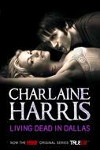
Attempting to make those who live in darkness see the light.
Publisher: Gollancz (Orion Books)
Pages: 279
Type: Fiction
Age: Adult
ISBN: 978-0-575-08938-9
First Published: 2002
Date Reviewed: 26th January 2012
Rating: 4/5
Considering she had agreed to work for Eric, it was unlikely that the vampires were going to leave her alone with her 19th Century boyfriend, living life as before. First Sookie discovers her co-worker’s dead body in Andy Bellefleur’s car, and then Eric calls her up about a mystery he’s signed her up for. Sookie’s telepathic power is the one needed in order to find out where the missing person is. It may also help her find out what happened to LaFayette.
If the first book in the series, Dead Until Dark, was a funny but gruesome and truly adult novel that was a good read, Living Dead In Dallas takes it up a level. There is perhaps more sexual content in this one, and more blood and guts, and it’s not always an attractive read, but Harris is now in the prime position to introduce her readers to what she really wants to say.
It’s rather interesting in fact that a comical book about vampires could have such a message, but it works, and Harris comes up trumps, able to not only deliver the message but to illustrate how seemingly contrasting lifestyles can be blended into one. This wouldn’t make sense in any other situation.
“Andy let a black queer sleep in his car?” This was Holly, who was the blunt straightforward one.
“What happened to him?” This was Danielle, who was the smarter of the two.
Harris portrays quite a lot of sexual orientation differences and gender bending, and in her world it is the norm because what has now taken over as the big taboo is the recognition of the undead being on earth. Instead of picking on sexuality, people have turned their distaste to vampires. This doesn’t mean of course that everything else has been defined as natural, but in this world, vampires are the brunt of prejudice. To use the simplest case of this change in society, one minor character tells how her parents would’ve preferred her to date an African American rather than a vampire.
But of course unlike groups generally prescribed discrimination, there is at least a true danger in the vampires. While they have been accepted into mainstream society, the vampires do not always behave well and this is a constant issue between the heroine and her boyfriend. While their relationship certainly pertains to Harris’s fantasy world, she does touch on things that relate to connections in the real world. And while Harris’s goal does seem to be to revel in her paranormal genre, and to provide black humour as well as lighter laughs, there is the sense that she wants to get her teeth into our actual world. Yes, that pun was definitely intended.
To be sure, as with Dead Until Dark and undoubtedly every other book in this series, Living Dead In Dallas may require a suspension of a lot of principles. These characters will have sex, a lot, and it’s not always vanilla.
Sookie is proving to be a very strong character. Whilst not fitting the mould of your standard strong heroine, she proves that one can be different and still be just as effective. And she remains strong through tough situations, when characters in other books would be given a sudden personality changes and made into weaklings.
Albeit at different speeds, the major characters are being developed. Sookie, as narrator, has already told the reader a lot about herself, so in most cases her development is in learning how to use her power. But her relationship with Bill, as discussed, provides times for new thoughts to enter her always-busy head. Bill himself is developed in drips and dabs (intended again) but it is given a lot of time when it happens. In regards to Sam’s ability, there are some revelations there too.
Living Dead In Dallas is proof that there can be balance found in the world of paranormal fiction, between books with flimsy females and books with out and out horror. And Harris demonstrates that if done right, there can be a place for humour too.











